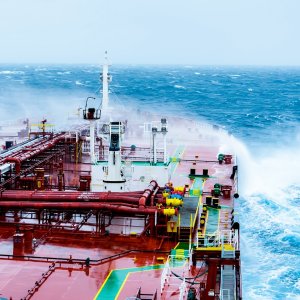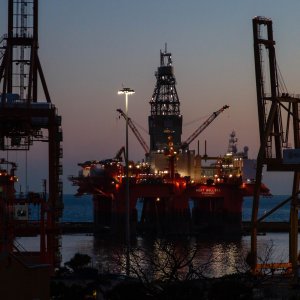
Treasure Waiting to Be Found in Deepwaters
Deepwater Mexico has the clear potential to bring Mexican oil and gas production back to its former levels, or even higher. According to data from PEMEX and CNH, approximately 25 percent of Mexico’s prospective resources, meaning about 28 billion boe, are located in Mexican deepwaters, but before the Energy Reform it was almost impossible for PEMEX to conduct exploration and appraisal activities in this arena by itself. The Trion farmout and the 27 blocks allocated to IOCs during the deepwater licensing rounds marked a milestone in Mexico’s oil and gas industry.
A DEEPWATER GIANT TO BE UNLEASHED
Pedro Joaquín Coldwell, Minister of Energy, highlights the international proven interest in deepwater Mexico, especially during Round 2.4. “Mexico has consolidated itself as an attractive destination for deepwater investments with a total awarded area of 44,178km during Round 2.4, which is double the area awarded in Brazil’s Round 14 and 21-fold the awarded surface of the US Round 249. Moreover, CNH reported that bids for these blocks were higher than those of Brazil and the US, with an average of 2.1 offers per block in Round 2.4 against an average of 1.3 and 1.1 offers per block in Brazil and the US, respectively. Another indicator is the average government take of 64.7 percent in Round 2.4, which is higher than the 55 percent historical average for deepwater blocks in the US.”
Much work has yet to be done in deepwater Mexico as the 27 blocks assigned during Rounds 1.4 and 2.4 are for exploration purposes rather than for production. This is why the biggest amount of committed investment will go to the deepwater arena. According to CNH, from the US$161 billion to be invested in the long term, 84 percent will be invested in deepwater activities. As reported by CNH, companies have offered upfront tiebreaker payments of US$1.14 billion, of which US$624 million corresponds to the payment made by BHP to win the Trion farmout. This represents almost 70 percent of the total tie-breaker payments generated by the licensing rounds. Furthermore, as of December 2017, the Mexican state has received over MX$304 million (US$15.2 million) thanks to the licensing rounds; deepwater activities represent 78 percent of that income.

PEMEX’S AMBITIONS
The NOC is working to change its culture and adapt to the new market conditions. It would have been easier for the company to just sit and wait for IOCs to take part in the exploration of untapped fields. Instead, the NOC made its first deepwater farmout in its Trion field. On the same day that PEMEX allocated Trion’s historic farmout, the NOC also participated in Mexico’s first-ever deepwater licensing round, Round 1.4, where it won Area 3 in the Perdido region in a consortium with Chevron and INPEX. Round 2.4 saw PEMEX win two blocks under a consortium, one with Shell and another with Chevron and INPEX and two blocks as a lone player.
The difference in results from Round 1.4 to Round 2.4 is a clear example of the steep learning curve PEMEX has gone through in the deepwater arena. David Johnson, Chairman of Alpha Deepwater Solutions, points to the synergies PEMEX must create with the right partners for the development of deepwater activities. “The perfect partner for PEMEX is a company that knows how to develop a deepwater field and will value PEMEX’s contribution,” he says. “The NOC has extremely detailed knowledge of its basins and more data than anyone else. It has a very good track record and is a world-class company, particularly in shallow water. The perfect partner for PEMEX would be a mid to large international oil company with people who know how to work with a partner that is still learning about the segment.”
This vision is shared by PEMEX itself, as explained by Ulises Hernández, Director of Prospective Resources, Reserves and E&P Associations at PEMEX, who highlights farmouts are and will remain the perfect tool for the NOC to gather important lessons in areas it has not been able to develop in the past. “Farmouts will continue focusing on the areas where PEMEX needs to complement its capacities, meaning mainly deepwater, high-risk onshore assets that need costly execution capacities to capture value and unconventional resources.”
A LONG-TERM VISION TO PRESERVE
Mexico’s port authorities from the Gulf of Mexico are looking with wide-open eyes at the upcoming increase in offshore activities. Jorge Ruiz, Director General of API Tuxpan, clearly recognizes the opportunities. “Tuxpan has the capacity to cater to the development of deepwater activities with equipment, personnel and logistics support, as the deepwater blocks in the Tampico-Misantla-Veracruz basin are located at a reasonable distance from the port,” he says. Tamaulipas will also tap into the potential golden egg, says Ricardo Correa, Director General of API Tamaulipas, Puerto de Matamoros, a port soon to be finished and that clearly aims to unlock the potential of the Perdido area. “The main shareholder in the Matamoros port is the government of Tamaulipas; therefore, we are making the planning much more integral with other ports in the state because it is now the state that is interested in its development and in connecting it with the future of the industry in Tamaulipas. Our objective is to make Matamoros the first truly deepwater port in Mexico.” With 45 percent of the committed investment expected to go to deepwater Tamaulipas, it comes as no surprise that the state is carefully preparing to take advantage of these investments with the construction of the port of Matamoros and with the creation of an Energy Regulatory Commission to administrate the state’s energy efforts.
While opportunities are many in deepwater, Joaquín Coldwell says the country must maintain a long-term mentality when talking about deepwater activities. “Deepwater blocks will take between eight to 10 years before moving into production phase due to the longer maturity period they require and the larger early-stage investments to locate the oil present at depths from 1-3km,” he says. This is supported by Alberto de la Fuente, Director General of Shell Mexico. “Specifically in deepwater applications and because of their technologydriven nature, Mexico still lacks the capabilities to compete on a global scale.” With a clear commitment, de la Fuente also suggests that IOCs with more experience can act as a springboard to increase deepwater operations. “Shell and other players will introduce more technology for local players to do more for the country’s development.”

















